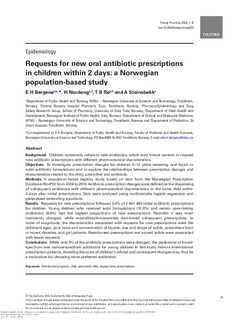| dc.contributor.author | Bergene, Elin Høien | |
| dc.contributor.author | Nordeng, Hedvig Marie Egeland | |
| dc.contributor.author | Rø, Torstein Baade | |
| dc.contributor.author | Steinsbekk, Aslak | |
| dc.date.accessioned | 2018-08-30T09:03:23Z | |
| dc.date.available | 2018-08-30T09:03:23Z | |
| dc.date.created | 2018-07-27T10:11:56Z | |
| dc.date.issued | 2018 | |
| dc.identifier.citation | Family Practice. 2018, . | nb_NO |
| dc.identifier.issn | 0263-2136 | |
| dc.identifier.uri | http://hdl.handle.net/11250/2560003 | |
| dc.description.abstract | Background
Children commonly refuse to take antibiotics, which may induce parents to request new antibiotic prescriptions with different pharmaceutical characteristics.
Objectives
To investigate prescription changes for children 0–12 years receiving oral liquid or solid antibiotic formulations and to explore the relationships between prescription changes and characteristics related to the child, prescriber and antibiotic.
Methods
A population-based registry study based on data from the Norwegian Prescription Database (NorPD) from 2004 to 2016. Antibiotic prescription changes were defined as the dispensing of subsequent antibiotics with different pharmaceutical characteristics to the same child within 2 days after initial prescriptions. Data were analysed using multivariable logistic regression and generalized estimating equations.
Results
Requests for new prescriptions followed 3.0% of 2 691 483 initial antibiotic prescriptions for children. Young children who received solid formulations (10.9%) and certain poor-tasting antibiotics (8.6%) had the highest proportions of new prescriptions. Penicillin V was most commonly changed, while macrolides/lincosamides dominated subsequent prescriptions. In order of magnitude, the characteristics associated with requests for new prescriptions were the children’s ages, poor taste and concentration of liquids, size and shape of solids, prescribers born in recent decades, and girl patients. Reimbursed prescriptions and scored solids were associated with fewer requests.
Conclusions
While only 3% of the antibiotic prescriptions were changed, the preference of broad-spectrum over narrow-spectrum antibiotics for young children in this study mirrors international prescription patterns. Avoiding the costs of children’s refusal and consequent changes may thus be a motivation for choosing more preferred antibiotics. | nb_NO |
| dc.language.iso | eng | nb_NO |
| dc.publisher | Oxford University Press (OUP) | nb_NO |
| dc.relation.uri | https://academic.oup.com/fampra/advance-article/doi/10.1093/fampra/cmy033/4994281 | |
| dc.rights | Navngivelse-Ikkekommersiell 4.0 Internasjonal | * |
| dc.rights.uri | http://creativecommons.org/licenses/by-nc/4.0/deed.no | * |
| dc.title | Requests for new oral antibiotic prescriptions in children within 2 days: a Norwegian population-based study | nb_NO |
| dc.type | Journal article | nb_NO |
| dc.type | Peer reviewed | nb_NO |
| dc.description.version | publishedVersion | nb_NO |
| dc.source.pagenumber | 8 | nb_NO |
| dc.source.journal | Family Practice | nb_NO |
| dc.identifier.doi | 10.1093/fampra/cmy033 | |
| dc.identifier.cristin | 1598794 | |
| dc.description.localcode | © The Author(s) 2018. Published by Oxford University Press. This is an Open Access article distributed under the terms of the Creative Commons Attribution Non-Commercial License (http://creativecommons.org/ licenses/by-nc/4.0/), which permits non-commercial re-use, distribution, and reproduction in any medium, provided the original work is properly cited. For commercial re-use, please contact journals.permissions@oup.com | nb_NO |
| cristin.unitcode | 194,65,15,0 | |
| cristin.unitcode | 194,65,20,0 | |
| cristin.unitname | Institutt for klinisk og molekylær medisin | |
| cristin.unitname | Institutt for samfunnsmedisin og sykepleie | |
| cristin.ispublished | true | |
| cristin.fulltext | original | |
| cristin.qualitycode | 2 | |

